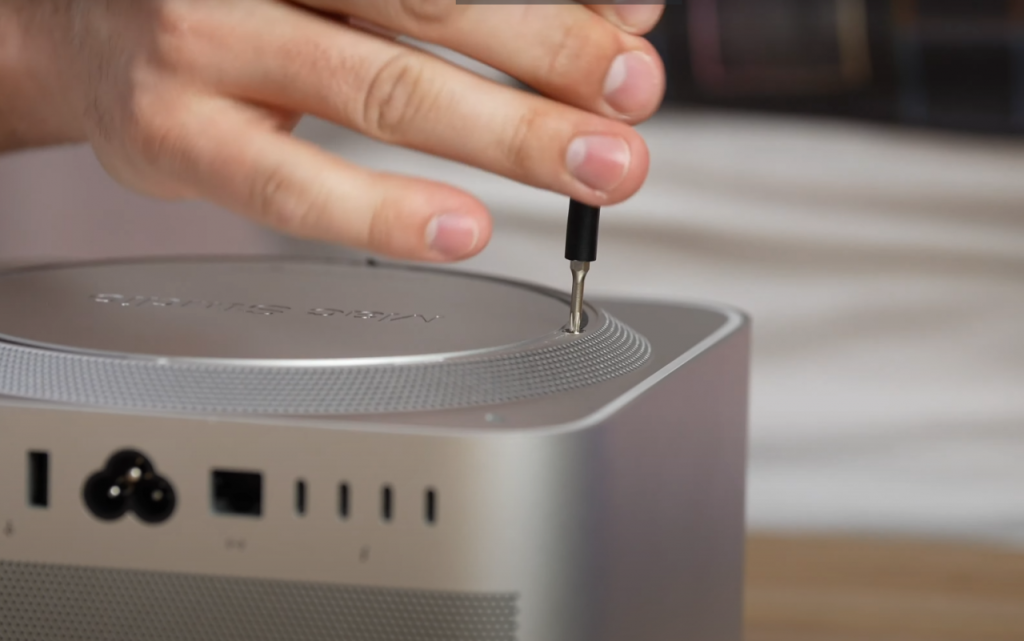Last week, Apple continued the mission of providing the Mac family with its own system chips, and the latest addition is a desktop computer the size of two stacked Mac Minis. Despite its small size, the new Mac Studio can be equipped with Apple’s most efficient system circuit today, the M1 Ultra with up to 20 CPUs, 64 graphics cores and 128 GB of system memory.
In the presentation, the company showed performance numbers that put the M1 Ultra against high-performance PC components. According to Apple, its own circuit could outperform the Resistance in both power efficiency and absolute performance, but now that independent testing is starting to look ahead, it’s clear that the latter isn’t necessarily true. Max Tech’s Youtube channel also focuses on taking a closer look at how Mac Studio is organized.
Just like with the Mac Mini, it’s an aluminum deck and in this all components are installed. Concealed screws hold the bottom in place and under the perforated bottom plate is the grille portion. Unprotected components of the power supply indicate that Mac Studio is not designed for users to tamper with the computer, but despite this, there is free space for storage devices. In practice, it is thus possible to upgrade the amount of storage afterwards.
However, the system memory and the M1 circuit are soldered and are in direct contact with the heat sink that occupies a large part of the top of the chassis. With the M1 Ultra, the heat sink is made of copper, while the M1 Max option uses aluminum. According to Max Tech, there is a distinct difference in weight, but both models are a little heavy in the rear. Behind the heat sink are dual fans. Finally, it can be added that all connections are separate units and therefore can be replaced if they break, but the disassembly work to access them is extensive.
Performance in Mac Studio
With the M1’s more powerful circuits, Apple is putting a lot of gunpowder on hardware resources for video processing, which can be seen in already expanded graphics and many built-in media stacks. This is why many tech-oriented Youtube channels are showing interest in the M1 Ultra, with MKBHD and Dave2d being two examples.
The previous profile currently uses powerful variants of Apple’s Intel-based Mac Pro systems and the result is that the M1 Ultra performs very well, but no better than the Mac Pro in video editing contexts. However, the media stacks mean that video rendering from Final Cut Pro is faster, but at exactly the same level as the M1 Max. The M1 Ultra is based on two interconnected M1 Max circuits, but unsurprisingly, the performance gains aren’t really double. Both are enough for hard work and the Mac Studio format is experienced as quiet and compact.
The same features are also highlighted in M1 Studio’s test of Dave2d, which, however, does not place the same emphasis on video production. In testing, the M1 Ultra was compared to the M1 Max, Intel Core i9-12900K, and Ryzen 9 5950X in the Geekbench 5 and Cinebench R23 synthetic tests. In previous testing, Apple’s new addition is clearly on top, while the x86-based alternatives are stronger in the Cinebench R23. When the latter is paired with the Geforce RTX 3090, they’re much more visible in Blender 3.1’s metallic rendering, but are overtaken by the M1 Ultra in Adobe Premiere’s video rendering.
Dave2d highlights that many programs rely entirely on single-wire performance, which is very good with the M1 Ultra, but the same performance as with the simpler M1 circuits. In this way, Dave2d and MKBHD agree that only at heavier loads can the steepest circuit extend the legs. The duo concludes that those who should invest in a Mac Studio PC already know they need it and what it is going to be used for.

“Entrepreneur. Freelance introvert. Creator. Passionate reader. Certified beer ninja. Food nerd.”







More Stories
Logitech Steering Wheel News: New Steering Wheels, Gear Lever, and Handbrake in Direct Drive Series
Garmin Launches inReach Messenger Plus App
Why Rare Earth Metals for Electric Cars Are Crucial for Modern Mobility